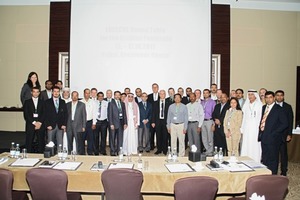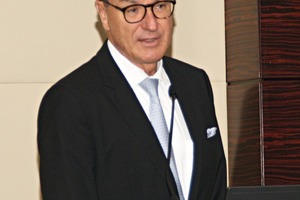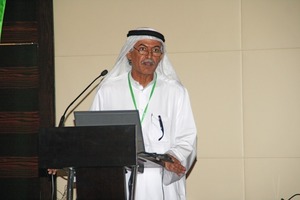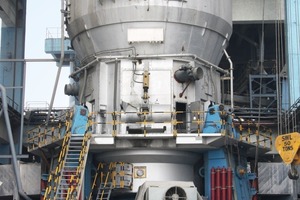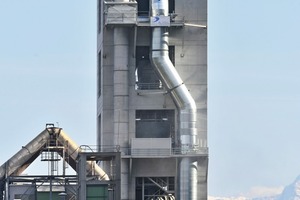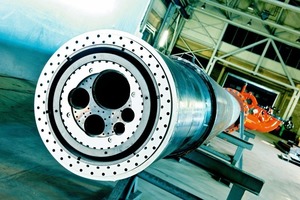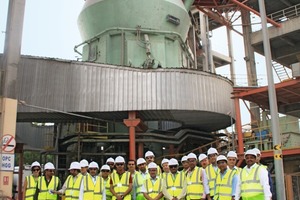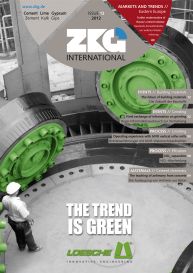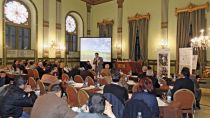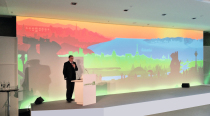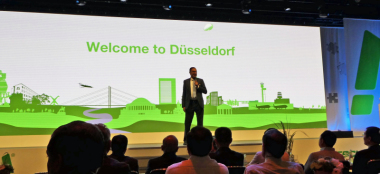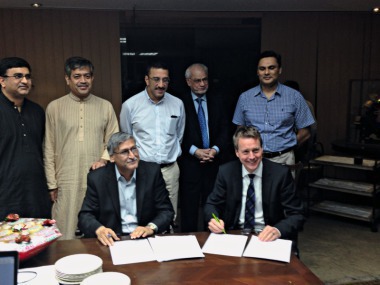Interesting lectures and a highly vivid exchange of information were part of the agenda of the first Round Table for the Arabian Peninsula (Fig. 1) that was held by Loesche GmbH. Dr Thomas Loesche (Fig. 2), Managing Director of Loesche, welcomed approximately 40 participants and described the long years of experience of the family-run business in the raw material, cement, and granulated blastfurnace slag grinding sector with its headquarters in Düsseldorf/Germany. Over the last few years, the company has been successful in expanding the product and service portfolio through several acquisitions and investments in other companies. Following the recent acquisition of a 60 % share in A TEC, Loesche can now offer its services for the pyroprocess.
Making use of the synergistic effects
In the second lecture, Gerhard Salewski pointed out that Loesche offers innovative engineering for innovative customers. This approach is centred on the 3E strategy: lower energy costs, higher efficiency, and an improved environment. Loesche, as a dry-grinding expert, and A TEC, with its pyroprocess know-how, can make use of the synergistic effects and support their customers already after a very brief period of shared company history. For example, the technologies offered by A TEC, e.g. the Hurriclones, can be used in Loesche grinding plants where they reduce the differential pressure and increase plant efficiency. Together with Greco, the entire process, from the coal grinding plant to the burner, can be realised.
Cyclical thinking
M. Al Ghurair (Fig. 3) talked about the importance of business cycles. He explained that the understanding of cyclical processes is essential for a long-term, positive business development. Experience in the Emirates has shown that these cycles cover approximately seven years. During periods of increasing demand, the plant strategy must focus on securing the production, while during periods of decreasing demand, the process optimisation, e.g. in view of a “greener” cement production, can be put into the focus. However, it is always important to give the on-site engineers sufficient room in order to provide them with a maximum level of freedom for the development of new ideas. This is the only way to ensure that the correct modernisation, maintenance, and optimisation measures can be taken at the right time.
Optimised products for different areas of application
Thomas Fahrland then presented the Loesche product portfolio. The company has sold nearly 1900 mills for raw materials, coal, clinker, and granulated blast-furnace slag worldwide (Fig. 4). Loesche coal mills are fully encapsulated and pressure-shock-resistant. Cement mills and mills for granulated blastfurnace slag are usually equipped with the well-known master and support rollers in order to ensure the optimum preparation of the grinding bed and, thereby, high levels of throughput and product quality. The modular design concept enables an easy and structured mill upscaling depending on the specific requirements since proven individual components with a well-known and reliable performance can be used. In addition, high maintenance-friendliness and minimised stockkeeping of spare parts are achieved as those modules are used in cement raw material-, coal-, and cement-mills.
Efficient cement grinding
Dr Daniel Strohmeyer then talked about the topic of cement grinding and provided an overview of the history of grinding technology. The first Loesche mill for cement clinker was commissioned in 1935. 2010 marked the commissioning of the largest cement mill, an LM 63.3+3 with a capacity of 375 t/h of Portland cement with a Blaine value of 3000 g/m2. At Loesche, the analyses accompanying new projects often begin on a laboratory scale when the grindability characteristics of samples provided by the customer are determined. These self-determined grindability factors are then used for the extrapolation to real grinding plants based on proportionality factors. However, the requirement profiles can change over the years. There is an increasing trend towards customised solutions, multi-component systems, a greater product variety and finer products.
Case studies
Enis Bostanci, Project Coordinator Sintek, demonstrated, based on an example, why a decision was made in favour of a vertical mill instead of a ball mill for a project in Turkey. The main criteria for the decision were the high level of flexibility of this type of grinding plant and the lower energy demand with a comparable water demand and product quality. Dr Kader Bensalem could report similar findings for North Africa. Clear requirement profiles were defined for a series of projects, e.g. at the FES production site in Ras El Ma (2004 and 2012) as well as for the Settat project. However, the weighting of the individual parameters varies from country to country. While the specific energy consumption is irrelevant in some countries, it is one of the main decision criteria in other countries. Other decision factors were the high level of satisfaction with Loesche VRMs in other projects, optimised stockkeeping of spare parts, and low operating costs.
Energy-efficient alternative
Dr Strohmeyer spoke in detail about the frequently asked question as to whether ball mills or vertical mills should be used for cement grinding. After a brief presentation of the theoretical fundamental grinding principles, he explained that the particle size distribution of both systems is comparable provided that the systems are adjusted correctly. The common prejudice of a higher water demand cannot be sustained if the particle sizes, which are important for processing, are taken into consideration. It is true that a lower level of gypsum dehydration may occur, e.g. due to the shorter dwell time in a vertical mill, but it can be easily compensated by applying rather simple countermeasures. Dr Strohmeyer once more underlined that vertical mills are an energy-efficient alternative to ball mills and he proved this by a series of case studies.
Higher efficiency through innovation
Michael Keyssner then presented the current product developments at Loesche. The grinding process is rather complex, which is why the optimum determination of the plant parameters is highly important. With four laboratory grinding plants, Loesche can simulate numerous product and plant configurations. A classifier test station is also available. DEM (discrete element method) and CDF (computational fluid dynamics) simulations provide an insight into the process details as well as information concerning potential optimisations. Together with the major motor and gear unit manufacturers, Loesche can also offer customised drive solutions. Apart from the standard drive concepts, EMPP drives made by Siemens or COPE drives made by Renk enable the operation of large-scale grinding plants with reliable components. EMPP (Siemens) is a double planetary gear set with an integrated motor. COPE (Renk) is a multiple spur planetary gear set with flange-mounted electric motors. Three to six standard 6-pole asynchronous motors can be used. The drives can be removed easily within just 2-4 hours in the event of a failure and the grinding process can continue with reduced power. Another Loesche innovation is the LDC classifier, which is equipped with a vortex rectifier. It optimises the gas flow and already classified material can no longer fall back into the classifier rotor in the centre of a rotational flow due to gravitational forces, which would have a negative effect on the performance. In a test set-up, energy savings of the fan motor of 4-8 % could be achieved with the new classifier, which means highly compact plant configurations can be realised.
Pyroprocess solutions
In the last session, A TEC and Greco presented their products and services (Fig. 5). Wilfried Zieri stressed that A TEC offers not only the optimisation of pryroprocesses and consulting services, but - through A TEC China- also the supervision of engineering and production processes in China. The range of services extends from audit and consulting projects up to the complete project realisation with general contractors. In addition, several new and application-specific product solutions were presented. Among other things, A TEC is at present in the process of developing a bypass dust treatment system. A new process for Hg suppression is also under development. Other special and advanced products by A TEC are special pendulum flaps, splash boxes, tertiary air gates, and meal splitters. Many of these products, e.g. the HE Cyclone 3 and the Hurrivane 3, can lead to considerably higher efficiency by increasing the separation performance or by reducing the pressure drop. Wilfried Zieri mentioned that, under a preventive maintenance management, special attention must be paid to the intrusion of infiltration air, since infiltration air has a strong effect on the process efficiency.
Christian Helmreich of Greco then presented a burner technology highlight, the new Flexiflame HMB (high-momentum burner). Greco is a global player, since the foundation of the company in 1966, it has successfully developed and implemented innovative burner concepts (Fig. 6). Christian Helmreich also presented a new fuel system for liquid alternative fuels. These burners of the most recent generation stabilise the kiln operation and increase the fuel efficiency. The control of the sintering zone length is improved and a higher level of clinker reactivity can be realised. This is complemented by a lower volatility and recirculation of sulphur in the kiln gas. Last but not least, there is a lower level of ring formation in the kiln body and the clinker granulometry is more homogeneous. Christian Helmreich explained the various areas of application based on several examples.
Conclusion
Dr Thomas Loesche was the last speaker of the day. He described once again that, already after a relatively short period of co-operation with A TEC Greco, numerous synergistic effects have presented themselves and he stressed that these synergies should be further expanded in the future. In between the lectures, the participants had numerous opportunities to ask for additional details, speak about their own experiences, and discuss the aspects concerning their own plant configuration. The social programme after the lectures and on the eve of the event provided ample opportunity for an exchange of information. On the agenda of the second day of the Round Table was a visit to the Cemex slag and cement grinding plant Jebel Ali (Fig. 7). The participants were able to get an impression of the stand-alone Loesche LM 56.3+3 mill that is in use at the plant.

